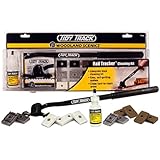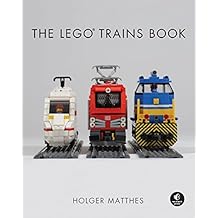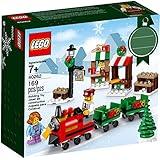|When it builds up on the tracks, it can prevent proper electrical connection.
Although it is less noticeable for high speed trains that run around in a big loop, many of us are also downsizing to smaller layouts due to lack of space. This leads to lower speed shunting layouts with Class 08s crawling at low speeds and over pointwork which can be very susceptible to dirt.
Track Cleaning Alternatives
Here's a brief overview of (almost) all the options, plus links to examples:- Hornby track cleaning coach - small yellow coach, a bit garish but functional, with old-style D couplings;
- Gaugemaster track cleaning pads - pads that hang below the axle of any coach/truck, but do not scrape or press down at all, so only really good when used in conjunction with a high frequency electronic track cleaner (see below);
- Dapol track cleaner - motorised track cleaning locomotive: expensive but effective, pair up with Dapol rack cleaning fluid;
- Track rubber - simple, effective, and quite time consuming (also, you need to be able to reach all corners of the layout);
- Electronic track cleaner (Gaugemaster) - always-on, detects instants when connectivity is broken, and uses a high frequency current to burn off any dirt before it can build up;
- Track cleaning kit (Woodland Scenics, pictured) - contains everything needed to thoroughly clean your track, including a telescopic arm on which you can mount the cleaning pad to reach the most distant corners of your layout.
 Essentially, there are three different approaches to cleaning track, one of which (the electronic cleaner) is more about prevention than cure.
Essentially, there are three different approaches to cleaning track, one of which (the electronic cleaner) is more about prevention than cure.Of the other two, there is a difference between the more abrasive approach of the Dapol, Hornby and track rubber solutions which rely on scraping to remove dirt, and the pad approach, which is gentler.
Cleaning solutions that use scraping need two things -- downwards pressure on the track, and movement, usually powered.
The Hornby cleaning coach needs to be pushed around by a locomotive (and comes in at around £30), whereas the Dapol track cleaning unit is self-powered, but also over twice the price (expect to pay around £70).
Everything else requires good, old-fashioned, elbow grease.
Tips for Better Results when Cleaning Track
There are a number of reasons why keeping track clean is a good idea. Besides the obvious -- dropping power and stopping -- any dirt that is present on the tracks will be picked up by locos and can get deposited on the pickups causing a longer-term issue.
So, the first key to keeping tracks clean might appear counter intuitive -- keep the loco wheels clean!
It is also important to avoid over-oiling the tracks as this will affect running and pulling power, is it may cause the wheels to slip. However, light oiling can help protect the tracks and prevent dirt build-up, so some model rail enthusiasts swear by it, usually using a citrus based product.
Finally, for the best wipe-off cleaning results, an alcohol based fluid or cleansing wipe, or good old lighter fluid (but be warned, it's highly flammable!) is a good option.
However, as I point out in my Hornby Track Cleaning Coach article, a dedicated track cleaning truck, or coach, cannot be beaten.





